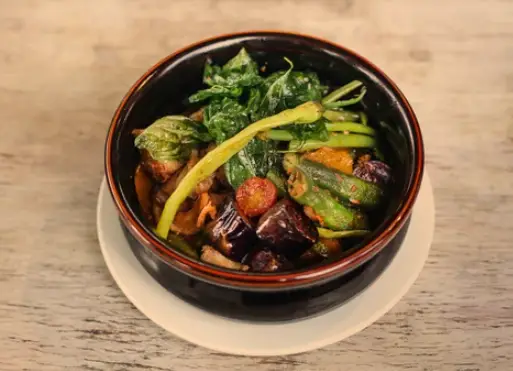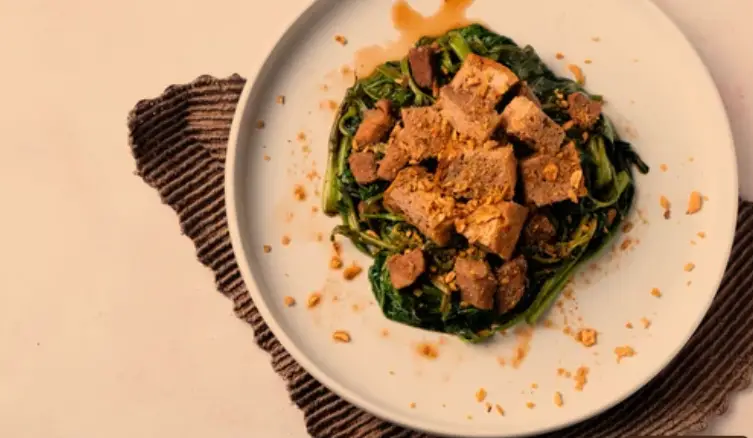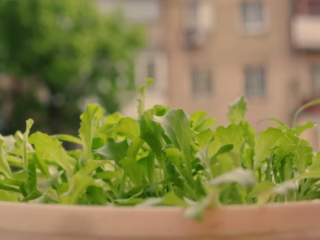Filipino cuisine is renowned for its diverse flavors and unique combinations.
While meat-based dishes often take center stage, the Philippines also boasts an array of delicious vegetable dishes that showcase the country’s culinary heritage.
We will explore some traditional Filipino vegetable dishes that not only delight the taste buds but also reflect the cultural richness and love for fresh ingredients in Filipino cooking.
Adobong Kangkong (Water Spinach):

Filipino Vegetable Dishes
Adobong Kangkong is a delightful and easy-to-make Filipino vegetable dish that features the fresh and tender water spinach, also known as kangkong. This flavorful dish is a vegetarian version of the classic Filipino Adobo, which is traditionally prepared with meat.
Ingredients:
- 2 bunches of fresh kangkong (water spinach) leaves, cleaned and trimmed
- 4 tablespoons soy sauce
- 2 tablespoons vinegar (cane or coconut vinegar)
- 4 cloves of garlic, minced
- 1 medium-sized onion, chopped
- 1 teaspoon black pepper
- 2 tablespoons cooking oil
- 1 cup vegetable broth or water
- Optional: red pepper flakes or chopped chili (for a spicy kick)
Instructions:
- Prepare the Kangkong Leaves: Wash the kangkong leaves thoroughly in cold water and trim off any tough stems. Separate the leaves from the stalks, as the stalks take longer to cook.
- Sauté the Aromatics: In a large pan or wok, heat the cooking oil over medium heat. Add the minced garlic and chopped onions, and sauté until the onions become translucent and the garlic turns lightly golden.
- Add the Kangkong Stalks: If you prefer using the kangkong stalks, add them to the pan and sauté for a few minutes until they begin to soften.
- Season with Soy Sauce and Vinegar: Pour the soy sauce and vinegar over the sautéed aromatics. Mix well and let the mixture simmer for a minute or two, allowing the flavors to meld.
- Incorporate the Kangkong Leaves: Add the kangkong leaves to the pan and toss them in the sauce until they are evenly coated. If you like a little heat, this is the time to add some red pepper flakes or chopped chili.
- Pour the Vegetable Broth: Pour the vegetable broth or water into the pan, ensuring that the kangkong leaves are submerged in the liquid. This will help in cooking the leaves and infusing them with the savory sauce.
- Simmer and Season: Cover the pan and let the Adobong Kangkong simmer on low heat for about 5-7 minutes or until the leaves are tender but still vibrant green. Adjust the seasoning with black pepper and additional soy sauce or vinegar to suit your taste.
- Serve: Once the kangkong leaves are cooked to your desired tenderness, transfer the Adobong Kangkong to a serving dish. You can garnish it with some chopped green onions for added freshness.
- Enjoy: Adobong Kangkong is best enjoyed with steamed white rice. The savory and tangy flavors of the dish complement the mild taste of rice perfectly.

Traditional Filipino Vegetable Dishes
This Adobong Kangkong recipe showcases the essence of Filipino flavors and demonstrates how simple ingredients can come together to create a delectable and healthy vegetable dish. Whether you’re a vegetarian or simply looking to explore Filipino cuisine, Adobong Kangkong is a must-try!
Pinakbet:

Pinakbet is a flavorful and nutritious Filipino vegetable stew that hails from the northern part of the Philippines, particularly the Ilocos region. This traditional dish is a colorful medley of various vegetables cooked in shrimp paste (bagoong) and sometimes accompanied by crispy pork belly (bagnet) for added richness.
Ingredients:
- 1 cup squash, peeled and cut into chunks
- 1 cup eggplant, sliced into rounds
- 1 cup bitter gourd (ampalaya), sliced and deseeded
- 1 cup okra, ends trimmed
- 1 cup string beans (sitaw), cut into 2-inch pieces
- 2 tablespoons cooking oil
- 2 cloves of garlic, minced
- 1 medium-sized onion, chopped
- 2 tomatoes, sliced
- 2 tablespoons shrimp paste (bagoong)
- 1 cup water
- Optional: 1/2 cup crispy pork belly (bagnet), cut into small pieces
Instructions:
- Prepare the Vegetables: Wash and cut the vegetables as specified in the ingredients list. The vegetables used in Pinakbet can be adjusted based on personal preference, so feel free to add other favorites like sweet potatoes or long beans if desired.
- Sauté the Aromatics: In a large pan or wok, heat the cooking oil over medium heat. Add the minced garlic and chopped onions, and sauté until they become fragrant and slightly translucent.
- Add the Tomatoes and Shrimp Paste: Toss the sliced tomatoes into the pan and continue sautéing for a minute or two until they start to soften. Then, add the shrimp paste (bagoong) and mix it well with the aromatics.
- Incorporate the Vegetables: Add the prepared vegetables to the pan one by one, starting with the sturdier ones like squash and bitter gourd, as they take longer to cook. Stir-fry the vegetables for a few minutes to coat them with the flavors of the sautéed aromatics and shrimp paste.
- Pour Water and Simmer: Pour the water into the pan, making sure it reaches about halfway up the height of the vegetables. Cover the pan and let the Pinakbet simmer over low to medium heat. Allow the vegetables to cook until they become tender but still retain their shape and vibrant colors.
- Optional: Add Crispy Pork Belly (Bagnet): For a non-vegetarian version, you can add crispy pork belly (bagnet) to the simmering Pinakbet. The bagnet provides a delightful contrast in texture and an extra layer of savory goodness to the dish.
- Adjust Seasoning: Taste the Pinakbet and adjust the seasoning according to your preference. You may add more shrimp paste for saltiness or a pinch of sugar to balance the flavors.
- Serve: Once the vegetables are cooked to perfection, transfer the Pinakbet to a serving dish. It’s best to enjoy this dish with steamed rice, as the flavorful sauce pairs excellently with the mild taste of rice.
Pinakbet is not only a delicious and comforting dish but also a showcase of the Philippines’ love for fresh produce and bold flavors. This vegetarian-friendly stew is a must-try for anyone seeking to delve into the heart of Filipino cuisine.
Laing:

Laing is a beloved Filipino dish that originates from the Bicol region in the Philippines. It is a spicy and creamy vegetable dish made from dried taro leaves cooked in rich coconut milk and flavored with chili peppers. This combination creates a unique and flavorful dish that represents the Philippines’ love for coconut-based cooking and bold, spicy flavors.
Ingredients:
- 2 cups dried taro leaves (if using fresh leaves, blanch them before cooking)
- 1 cup coconut milk
- 1 cup coconut cream
- 1 small onion, minced
- 4 cloves of garlic, minced
- 2 tablespoons shrimp paste (bagoong) or fish sauce (for a vegetarian option)
- 2-3 pieces of red chili peppers (siling labuyo), chopped (adjust to your preferred level of spiciness)
- 2 tablespoons cooking oil
- Optional: 1/2 cup cooked shrimp or small dried fish for added flavor (optional for non-vegetarian version)
Instructions:
- Prepare the Dried Taro Leaves: If using dried taro leaves, soak them in water for about 30 minutes to rehydrate them. After soaking, drain and set them aside. If using fresh leaves, blanch them in boiling water for a few minutes, then drain and chop them before cooking.
- Sauté the Aromatics: In a large pan or wok, heat the cooking oil over medium heat. Sauté the minced garlic and onions until they become fragrant and lightly golden.
- Add the Coconut Milk and Shrimp Paste (or Fish Sauce): Pour the coconut milk into the pan with the sautéed aromatics. Add the shrimp paste (bagoong) or fish sauce, and stir everything together. Let it simmer for a few minutes to allow the flavors to meld.
- Incorporate the Dried Taro Leaves: Add the soaked dried taro leaves or the blanched fresh taro leaves to the pan. Mix the leaves well with the coconut milk and aromatics, ensuring they are coated with the flavorful sauce.
- Add the Chopped Chili Peppers: Add the chopped red chili peppers to the pan, adjusting the amount to your desired level of spiciness. If you prefer a milder version, you can deseed the chili peppers before chopping them.
- Cook in Coconut Cream: Pour the coconut cream over the mixture in the pan. Stir everything together and let it simmer on low heat until the coconut milk and cream thicken and coat the taro leaves in a creamy sauce. The dish is ready when the taro leaves have softened, and the sauce has thickened.
- Optional: Add Cooked Shrimp or Dried Fish: For a non-vegetarian version, you can add cooked shrimp or small dried fish to the Laing. These ingredients add an extra layer of flavor and make the dish even more delicious.
- Serve: Transfer the Laing to a serving dish. Laing is best enjoyed with steamed rice, as the creamy and spicy flavors pair wonderfully with the mild taste of rice.
Laing’s combination of spicy chili peppers and creamy coconut milk creates a mouthwatering dish that exemplifies the unique and bold flavors of Filipino cuisine. Whether you’re a spice enthusiast or simply enjoy rich coconut-based dishes, Laing is sure to become a favorite in your culinary repertoire.
Ginisang Monggo (Mung Bean Stew):

Ginisang Monggo is a hearty and nutritious Filipino mung bean stew that is commonly enjoyed during Lent and other special occasions. This flavorful dish features mung beans cooked with various vegetables, making it a delicious and comforting option for both vegetarians and non-vegetarians alike.
Ingredients:
- 1 cup mung beans (munggo), soaked in water for at least 1 hour
- 2 tablespoons cooking oil
- 1 medium-sized onion, minced
- 3 cloves of garlic, minced
- 1 medium-sized tomato, chopped
- 1 cup malunggay leaves (moringa leaves) or spinach, washed and plucked from the stems
- 1 cup sliced eggplant
- 1 cup sliced ampalaya (bitter gourd), deseeded
- 1 cup sliced squash or sweet potato
- 4 cups vegetable broth or water
- 1 tablespoon fish sauce (patis) or soy sauce (for a vegetarian option)
- Salt and pepper to taste
- Optional: Cooked shrimp or pork pieces for added flavor (optional for non-vegetarian version)
Instructions:
- Prepare the Mung Beans: Rinse the mung beans thoroughly under running water and soak them in water for at least 1 hour. Soaking the beans helps reduce cooking time and aids in their digestion.
- Sauté the Aromatics: In a large pot or saucepan, heat the cooking oil over medium heat. Sauté the minced garlic and onions until they become fragrant and translucent.
- Add the Chopped Tomato: Add the chopped tomato to the pot and cook for a few minutes until it softens and releases its juices.
- Cook the Mung Beans: Drain the soaked mung beans and add them to the pot with the sautéed aromatics and tomatoes. Stir everything together.
- Pour the Vegetable Broth (or Water): Add the vegetable broth or water to the pot, covering the mung beans completely. Bring the mixture to a boil and then reduce the heat to low. Let the mung beans simmer for about 30 minutes or until they become tender and start to break down. Skim off any foam that forms on the surface during cooking.
- Incorporate the Vegetables: Once the mung beans are tender, add the sliced eggplant, ampalaya (bitter gourd), and squash or sweet potato to the pot. Continue simmering the stew until the vegetables are cooked through and tender.
- Season the Stew: Season the Ginisang Monggo with fish sauce (patis) or soy sauce for a vegetarian version. Adjust the seasoning with salt and pepper according to your taste preferences.
- Add Malunggay Leaves or Spinach: Add the malunggay leaves or spinach to the pot and cook for a few more minutes until they wilt and become tender. This addition adds a burst of vibrant green color and boosts the stew’s nutritional value.
- Optional: Add Cooked Shrimp or Pork (Non-Vegetarian Version): For a non-vegetarian version, you can add cooked shrimp or small pieces of pork to the stew. These ingredients enhance the flavor and make the dish heartier.
- Serve: Once all the vegetables are cooked and the flavors have melded together, the Ginisang Monggo is ready to be served. Ladle the stew into bowls and enjoy it with steamed rice.
Ginisang Monggo is not only delicious but also packed with protein and essential nutrients from the mung beans and vegetables. Its comforting taste and heartwarming qualities make it a beloved Filipino dish that families enjoy sharing during special gatherings and occasions.
Sinigang sa Miso:

Sinigang sa Miso is a delightful and savory Filipino sour soup that offers a unique twist on the traditional Sinigang. Instead of using the typical tamarind-based broth, this version incorporates miso paste, a fermented soybean product, which adds a rich umami flavor to the soup. The combination of tangy and savory elements makes Sinigang sa Miso a truly comforting and satisfying dish.
Ingredients:
- 500g pork ribs or belly, cut into serving pieces
- 2 tablespoons cooking oil
- 1 medium-sized onion, quartered
- 2 cloves of garlic, minced
- 2 medium-sized tomatoes, quartered
- 2 tablespoons miso paste
- 1 liter water or rice washing (hugas bigas)
- 1 cup radish (labanos), peeled and sliced
- 1 cup string beans (sitaw), cut into 2-inch pieces
- 1 cup eggplant, sliced
- 2 cups leafy greens (spinach, kangkong, or mustard greens)
- 2 pieces green chili peppers (siling pansigang)
- Fish sauce (patis) or salt to taste
- Optional: Other vegetables like okra or taro (gabi) can be added based on preference.
Instructions:
- Sear the Pork: In a large pot or Dutch oven, heat the cooking oil over medium heat. Sear the pork ribs or belly pieces until they turn brown on all sides. This step adds depth of flavor to the soup.
- Sauté the Aromatics: Add the minced garlic and quartered onions to the pot with the seared pork. Sauté them until the onions become translucent and the garlic is fragrant.
- Incorporate the Tomatoes and Miso Paste: Toss the quartered tomatoes into the pot and sauté for a few minutes until they soften. Then, add the miso paste to the pot, stirring it well with the other ingredients.
- Pour the Water or Rice Washing: Pour the water or rice washing into the pot, covering the pork and aromatics completely. Bring the mixture to a boil, then reduce the heat to a simmer. Let it cook until the pork becomes tender.
- Add the Vegetables: Once the pork is tender, add the sliced radish, string beans, and eggplant to the pot. These vegetables are traditional choices for Sinigang sa Miso, but you can add other favorites like okra or taro if desired.
- Season and Simmer: Season the soup with fish sauce (patis) or salt to taste. Allow the vegetables to cook until they are tender but still retain their shape and color.
- Incorporate the Leafy Greens and Chili Peppers: Add the leafy greens and green chili peppers to the pot. The leafy greens will wilt quickly, so be sure not to overcook them.
- Serve: Once the vegetables are cooked, the Sinigang sa Miso is ready to be served. Ladle the soup into bowls and enjoy it with steamed rice.
Summary
Conclusion: Filipino cuisine’s vegetable dishes are a celebration of fresh produce, cultural heritage, and flavorful cooking techniques. From the tangy Adobong Kangkong to the comforting Sinigang sa Miso, each dish exemplifies the country’s culinary diversity and passion for food. These vegetable dishes not only appeal to vegetarians but also introduce the world to the vibrant and distinct flavors of traditional Filipino cooking. So, the next time you’re exploring Filipino cuisine, don’t forget to savor the delightful and nutritious vegetable dishes that this gastronomic paradise has to offer.




